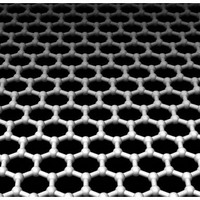Home > Press > Critical questions: Ripples in the structure of graphene could be the key to understanding its unusual characteristics
 |
| Figure 1: Graphene consists of a single layer of carbon atoms arranged in a hexagonal array. Its structure and two-dimensional nature gives rise to its unique and potentially useful electronic characteristics.
source: Wikimedia/Thomas Szkopek |
Abstract:
Graphene is a two-dimensional material that consists of a hexagonal array of carbon just one atom thick (Fig. 1). Although it is essentially just a single sheet of graphite, its properties are remarkable and unique. Notably, its charge carriers behave like massless relativistic particles, and move at a speed of just 300 times less than the speed of light—many times more quickly than in silicon. This makes graphene a potentially attractive alternative to silicon as future computer chips.
Critical questions: Ripples in the structure of graphene could be the key to understanding its unusual characteristics
Japan | Posted on October 19th, 2008Many questions remain about graphene. A numerical study conducted by an international team of physicists including Akira Furusaki of RIKEN's Advanced Science Institute in Wako, attempts to explain the unusual quantum Hall effect that arises in graphene, and the influence of disorder of its 2D structure on its behavior1.
The quantum Hall effect occurs in metal-like systems whose electrons are confined to move only in a two-dimensional plane. It is characterized by the emergence of plateaus in the conductance measured transverse to the flow of current through the system—known as the Hall conductance—when a large magnetic field is applied through the plane.
In graphene, the quantum Hall effect is subtly different to that in other 2D systems. Normally, the Hall conductance begins at zero and increases in exact increments, described as e2/h, with increasing magnetic field or charge concentration. In graphene, however, the conductance changes in multiples of 4e2/h and the whole characteristic is shifted by half this value.
Moreover, in most systems it is usually destroyed by disorder or by thermal fluctuations at temperatures much above absolute zero. But in graphene, it is remarkably insensitive to both, with the Hall plateaus around zero conductivity evident all the way up to room temperature.
The simulations performed by Furusaki and colleagues suggest that the robustness of the quantum Hall effect in graphene arises as a result of the relativistic nature of its charge carriers. Under certain amounts of disorder, the wavefunctions of zero-energy carrier states do not become localized in the same way as those of nonrelativistic carriers in conventional quantum Hall systems would. The researchers argue that the occurrence of such nonlocalized states—known as critical states—could explain why the initial Hall plateaus occur at +/- 2e2/h, rather than at zero before increasing in multiples of 4e2/h. Moreover, they argue that the expected occurrence of ripples in graphene's structure could be enough to cause these nonlocalized states to emerge.
Reference
1. Nomura, K., Ryu, S., Koshino, M., Mudry, C. & Furusaki, A. Quantum Hall effect of massless Dirac fermions in a vanishing magnetic field. Physical Review Letters 100, 246806 (2008).
The corresponding author for this highlight is based at the RIKEN Condensed Matter Theory Laboratory
####
For more information, please click here
Copyright © Riken
If you have a comment, please Contact us.Issuers of news releases, not 7th Wave, Inc. or Nanotechnology Now, are solely responsible for the accuracy of the content.
| Related Links |
| Related News Press |
News and information
![]() Researchers develop molecular qubits that communicate at telecom frequencies October 3rd, 2025
Researchers develop molecular qubits that communicate at telecom frequencies October 3rd, 2025
![]() Next-generation quantum communication October 3rd, 2025
Next-generation quantum communication October 3rd, 2025
![]() "Nanoreactor" cage uses visible light for catalytic and ultra-selective cross-cycloadditions October 3rd, 2025
"Nanoreactor" cage uses visible light for catalytic and ultra-selective cross-cycloadditions October 3rd, 2025
Chip Technology
![]() Lab to industry: InSe wafer-scale breakthrough for future electronics August 8th, 2025
Lab to industry: InSe wafer-scale breakthrough for future electronics August 8th, 2025
![]() A 1960s idea inspires NBI researchers to study hitherto inaccessible quantum states June 6th, 2025
A 1960s idea inspires NBI researchers to study hitherto inaccessible quantum states June 6th, 2025
![]() Programmable electron-induced color router array May 14th, 2025
Programmable electron-induced color router array May 14th, 2025
Discoveries
![]() Researchers develop molecular qubits that communicate at telecom frequencies October 3rd, 2025
Researchers develop molecular qubits that communicate at telecom frequencies October 3rd, 2025
![]() Next-generation quantum communication October 3rd, 2025
Next-generation quantum communication October 3rd, 2025
![]() "Nanoreactor" cage uses visible light for catalytic and ultra-selective cross-cycloadditions October 3rd, 2025
"Nanoreactor" cage uses visible light for catalytic and ultra-selective cross-cycloadditions October 3rd, 2025
Announcements
![]() Rice membrane extracts lithium from brines with greater speed, less waste October 3rd, 2025
Rice membrane extracts lithium from brines with greater speed, less waste October 3rd, 2025
![]() Researchers develop molecular qubits that communicate at telecom frequencies October 3rd, 2025
Researchers develop molecular qubits that communicate at telecom frequencies October 3rd, 2025
![]() Next-generation quantum communication October 3rd, 2025
Next-generation quantum communication October 3rd, 2025
![]() "Nanoreactor" cage uses visible light for catalytic and ultra-selective cross-cycloadditions October 3rd, 2025
"Nanoreactor" cage uses visible light for catalytic and ultra-selective cross-cycloadditions October 3rd, 2025
Quantum nanoscience
![]() ICFO researchers overcome long-standing bottleneck in single photon detection with twisted 2D materials August 8th, 2025
ICFO researchers overcome long-standing bottleneck in single photon detection with twisted 2D materials August 8th, 2025
![]() Programmable electron-induced color router array May 14th, 2025
Programmable electron-induced color router array May 14th, 2025
|
|
||
|
|
||
| The latest news from around the world, FREE | ||
|
|
||
|
|
||
| Premium Products | ||
|
|
||
|
Only the news you want to read!
Learn More |
||
|
|
||
|
Full-service, expert consulting
Learn More |
||
|
|
||








